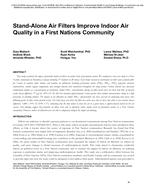Description
This study examined the impact of portable indoor air filters on indoor levels of particulate matter. We conducted a cross-over study in a FirstNations community in Manitoba, Canada including 37 residents in 20 homes. Each home received an electrostatic air filter and a placebo filterfor 1-week in random order. Indoor and outdoor air pollutants including particulate matter (PM10, PM2.5, PM1), polycyclic aromatichydrocarbons, volatile organic compounds, and nitrogen dioxide were monitored throughout the study period. Carbon dioxide was measuredcontinuously indoors as a measurement of ventilation. Indoor PM2.5 concentrations during air filter weeks were less than half those of placeboweeks (mean difference: 37 mu x g/m³, 95% CI: 10, 64) but remained approximately 5-times greater than outdoor concentrations owing to a highprevalence of smoking indoors. The impact of air filtration on indoor PM2.5 concentrations has been assessed by comparing total decay ratesfollowing peaks in filter versus placebo weeks. The total decay rate when the filter was active was close to twice that when it was inactive (meandifference: 1.08h-1, 95% CI: 0.99, 1.17), indicating that the time taken to clean the air to a given value is approximately halved by the aircleaner. Our findings suggest that portable air filters were able to effectively reduce indoor levels of particulate matter in a First Nationscommunity. However, indoor air filtration was not able to adequately mitigate the impact of smoking.
Citation: IAQ Conference: IAQ 2013: Environmental Health in Low Energy Buildings
Product Details
- Published:
- 2013
- Number of Pages:
- 5
- File Size:
- 1 file , 1.5 MB
- Product Code(s):
- D-2013IAQConf-06




